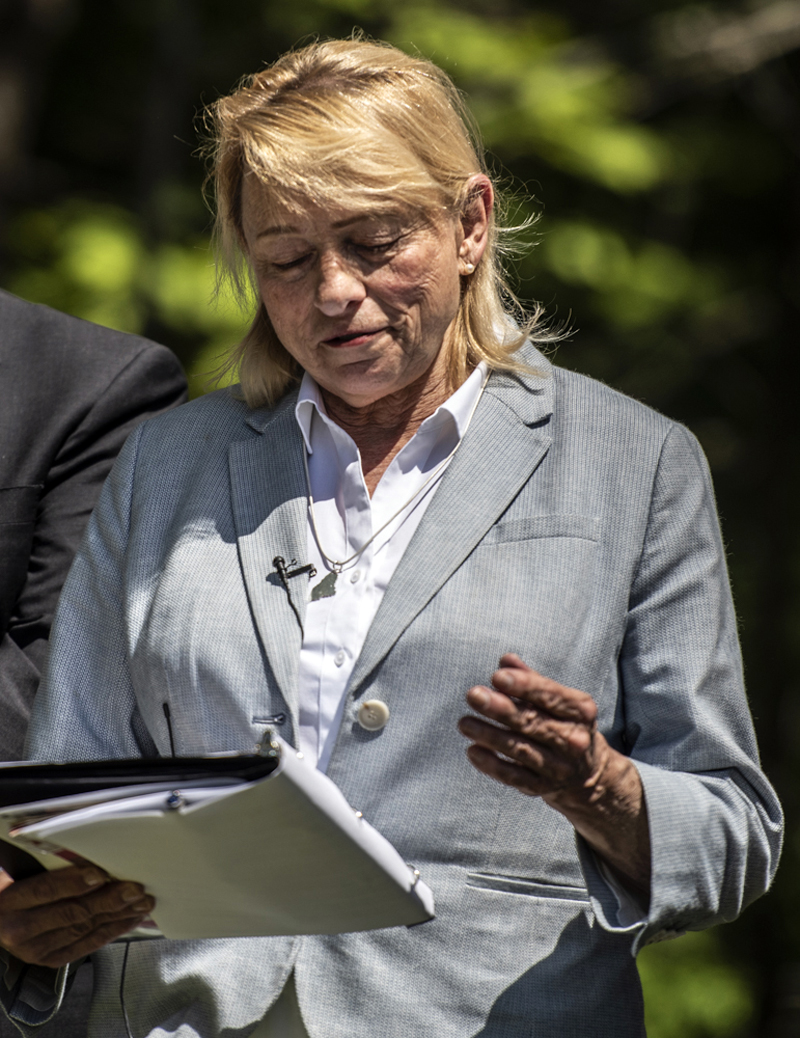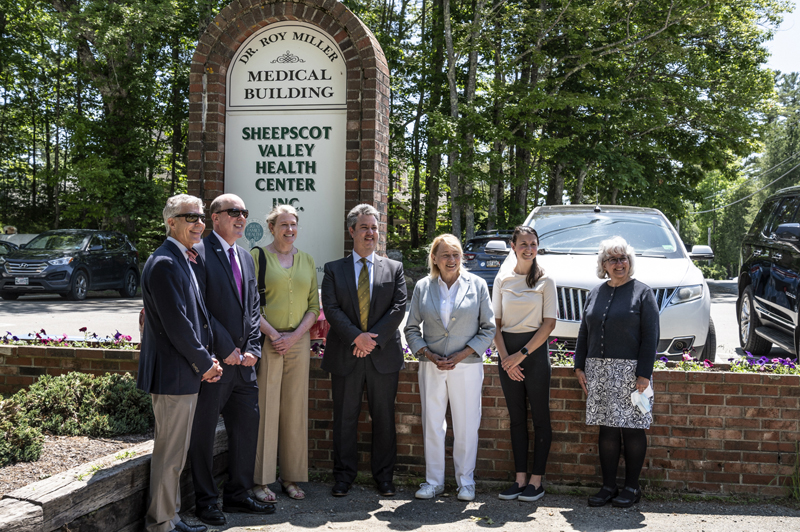
Maine Gov. Janet Mills stands in front of the Sheepscot Valley Health Center in Whitefield on Tuesday, June 7. Mills visited the location to announce a $4 million initiative to help boost Maine’s healthcare workforce. (Bisi Cameron Yee photo)
The Sheepscot Valley Health Center in Whitefield was the backdrop for Maine Gov. Janet Mills’ announcement of new initiatives aimed at attracting and retaining health care workers in the state. The $4 million that will fund the initiatives is part of the Mills administration’s Maine Jobs & Recovery Program, which includes $20 million targeted toward strengthening Maine’s health care workforce.

Gov. Janet Mills shares a moment with Sheepscot Valley Health Center family nurse practitioner Natalie Ledue in Whitefield on Tuesday, June 7. Ledue relied on a National Health Service Corps Scholarship to complete her education, and is an example of how funding healthcare education can attract and retain more providers in the state. (Bisi Cameron Yee photo)
“It’s community health centers like this one that deliver exceptional, affordable, and trusted care to people across the state of Maine,” Mills said.
The Sheepscot Valley Health Center has been serving area residents since 1980. In 2021 the center saw 2,869 patients including 411 from Whitefield, 327 from Jefferson, and 105 from Somerville.
“Community health centers throughout Maine provide primary health care services for some of our most rural and medically underserved communities,” said Connie Coggins, president and CEO of HealthReach Community Health Centers, the parent company of Sheepscot Valley Health Center. “Community health centers also serve patients irrespective of their income or ability to pay. We are Maine’s health care safety net.”
Coggins expressed support for the initiatives and thanked the Mills administration, noting that “the current recruiting environment for healthcare professionals has been the most challenging that we have faced in the last 20 years.”
Current staff at Sheepscot Valley includes five clinicians, a licensed clinical social worker, a part-time mental health nurse practitioner, and a part-time podiatrist.
Coggins said the center benefitted from national scholarship programs and she anticipates that the new state programs will be a boon to the workforce and to patients. “The more clinicians we recruit and retain, the better access to health care services for the community,” she said.
Natalie Ledue, a family nurse practitioner at the health center and a native Mainer, is a National Health Service Corps scholar who returned to Maine to fulfill a two-year service requirement tied to her scholarship. She exemplifies the potential impact of the newly announced state funding. “I’ve already completed my two years and I’m still here,” she said.
“We very much want to encourage our young people to pursue health care professions,” Andrew MacLean, of the Maine Medical Association. “We do not want cost to be a barrier to pursuing a medical education.”
Brian Wyatt, of the Maine Primary Care Association, said that health centers like Sheepscot Valley are located primarily in the state’s most rural and underserved communities and that it takes some health centers two to three years to recruit a provider.
Scholarship and loan repayment programs would “help entice … providers who are already being educated and trained in Maine to stay in Maine,” Wyatt said.

Maine Gov. Janet Mills announces $4 million for Maine Jobs & Recovery Plan initiatives at the Sheepscot Valley Health Center in Whitefield on Tuesday, June 7. Brian Wyatt, of the Maine Primary Care Association, and Connie Coggins, president and CEO of HealthReach Community Health Centers, also spoke. (Bisi Cameron Yee photo)
The Finance Authority of Maine will administer the programs. According to the organization’s website, funding is not limited to doctors and nurses. Occupational therapists, physical therapists, speech therapists, behavioral health care workers, licensed clinical social workers, dental hygienists, medical assistants, pharmacists, and health care technicians are all eligible to apply.
The Doctors for Maine’s Future Scholarship Program awards up to 50% of the cost of attendance or $25,000 annually renewable up to four years at Tufts University School of Medicine Maine Medical Center Program and the University of New England College of Osteopathic Medicine. Students must have a “substantial connection” to the state of Maine.

Connie Coggins, president and CEO of HealthReach Community Health Centers, speaks during an appearance by Gov. Janet Mills at the Sheepscot Valley Health Center in Whitefield on Tuesday, June 7. Coggins said Maine is facing the worst shortage in health care workers in 20 years. (Bisi Cameron Yee photo)
The Maine Health Care Provider Loan Repayment Pilot Program will attract and retain health care professionals in Maine by repaying up to $25,000 per year of outstanding student loans for selected participants who commit to living and working in Maine for at least three years.
The Nursing Education Loan Repayment Program provides student loan repayment assistance to registered nurses working in or relocating to Maine as nurse educators. There is not only a critical shortage of nurses nationwide, but also a critical shortage of professionals to train them. This program directly addresses that need.

Jeanne Lambrew, commissioner of the Maine Department of Health and Human Services, visits the Sheepscot Valley Health Center in Whitefield on Tuesday, June 7. Lambrew was one of several state dignitaries who attended an announcement by Gov. Janet Mills about increased funding for education to encourage the pursuit of health care careers in Maine. (Bisi Cameron Yee photo)
“These new scholarship and loan programs will bring more Maine people, especially young people, into the healthcare career workforce and enable them to live and practice in communities like this one … it’s a win-win for our state,” Mills said.
Later in the afternoon Mills toured the headquarters of Tidewater Telecom in Nobleboro, where she sat down with members of the Tidewater team to discuss new funding and how the administration’s broadband policy may align with company’s strategic plan.

Maine Gov. Janet Mills poses for a photo in front of a phone booth at Tidewater Telecom in Nobleboro on Tuesday, June 7. Mills visited the company to tour the facility and discuss broadband policy with Tidewater’s team. (Bisi Cameron Yee photo)
Alan Hinsey, Tidewater’s director of marketing, said the company works “pretty extensively” with the ConnectMaine Authority, which facilitates the availability of broadband to Maine households and businesses.
Hinsey said Tidewater’s objective is “to get as much fiber built out as we can.” He said the company is exploring creative ways to use fiber to link emergency departments and medical facilities throughout Lincoln County, calling the current funding atmosphere “a once-in-a-lifetime opportunity.”

Maine Gov. Janet Mills announces initiatives to provide funding for health care scholarships and loan repayment programs while at the Sheepscot Valley Health Center in Whitefield on Tuesday, June 7. The initiatives aim to increase Maine’s health care workforce. (Bisi Cameron Yee photo)
Once fiber is deployed, it will usher in “a whole new way of thinking about how we connect virtually,” Hinsey said. “We’ve only hit the tip of the iceberg when it comes to fiber.”
Mills said that broadband is a high priority right now. In recent months 35,000 homes and businesses throughout Maine have gained access to high-speed internet.
“We need to make sure every person in Maine who wishes to have it will have access to high speed internet by the end of 2024,” Mills said.

From left: Andrew MacLean, of the Maine Medical Association; Bill Norbert, of Finance Authority of Maine; Jeanne Lambrew, commissioner of the Maine Department of Health and Human Services; Brian Wyatt, of the Maine Primary Care Association; Maine Gov. Janet Mills; Family Nurse Practitioner Natalie Ledue; and Connie Coggins, president and CEO of HealthReach Community Health Centers, pose for a photo outside the Sheepscot Valley Health Center in Whitefield on Tuesday, June 7. The health center was the first stop on Mill’s tour of Lincoln County. (Bisi Cameron Yee photo)
The governor also spent time at the Washburn & Doughty Associates boat yard and the Bigelow Laboratory for Ocean Sciences, both in East Boothbay, as part of her visit to the county.
For information on the Doctors for Maine’s Future Scholarship go to: famemaine.com/affording-education/pay-for-school/maine-grant-tuition-programs/doctors-for-maines-future-scholarship.
For information on the repayment programs administered by the Finance Authority of Maine, go to famemaine.com/affording-education.



